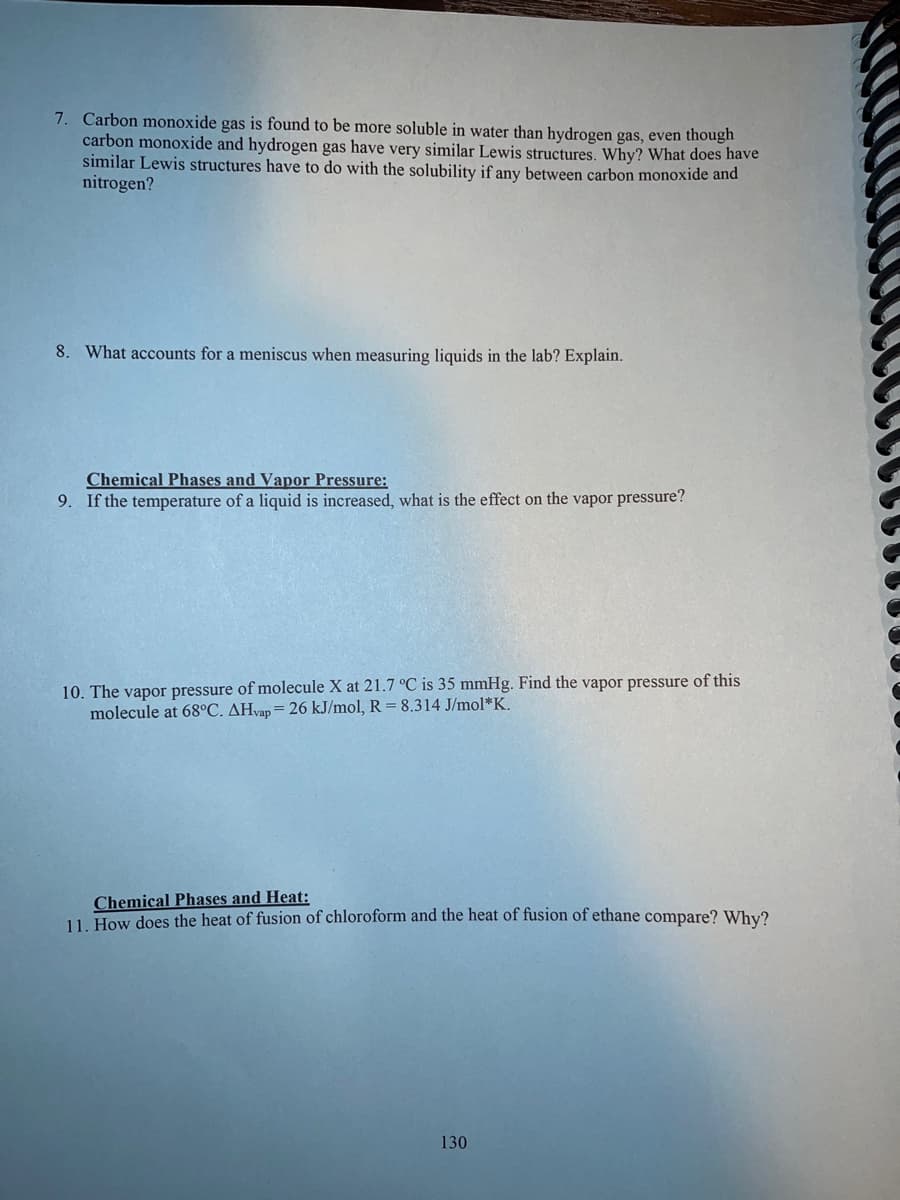7. Carbon monoxide gas is found to be more soluble in water than hydrogen gas, even though carbon monoxide and hydrogen gas have very similar Lewis structures. Why? What does have similar Lewis structures have to do with the solubility if any between carbon monoxide and nitrogen? 8. What accounts for a meniscus when measuring liquids in the lab? Explain. Chemical Phases and Vapor Pressure: 9. If the temperature of a liquid is increased, what is the effect on the vapor pressure? 10. The vapor pressure of molecule X at 21.7 °C is 35 mmHg. Find the vapor pressure of this molecule at 68°C. AHvap = 26 kJ/mol, R = 8.314 J/mol*K. Chemical Phases and Heat: 11 How does the heat of fusion of chloroform and the heat of fusion of ethane compare? Why?
7. Carbon monoxide gas is found to be more soluble in water than hydrogen gas, even though carbon monoxide and hydrogen gas have very similar Lewis structures. Why? What does have similar Lewis structures have to do with the solubility if any between carbon monoxide and nitrogen? 8. What accounts for a meniscus when measuring liquids in the lab? Explain. Chemical Phases and Vapor Pressure: 9. If the temperature of a liquid is increased, what is the effect on the vapor pressure? 10. The vapor pressure of molecule X at 21.7 °C is 35 mmHg. Find the vapor pressure of this molecule at 68°C. AHvap = 26 kJ/mol, R = 8.314 J/mol*K. Chemical Phases and Heat: 11 How does the heat of fusion of chloroform and the heat of fusion of ethane compare? Why?
Principles of Modern Chemistry
8th Edition
ISBN:9781305079113
Author:David W. Oxtoby, H. Pat Gillis, Laurie J. Butler
Publisher:David W. Oxtoby, H. Pat Gillis, Laurie J. Butler
Chapter14: Chemical Equilibrium
Section: Chapter Questions
Problem 94AP
Related questions
Question

Transcribed Image Text:7. Carbon monoxide gas is found to be more soluble in water than hydrogen gas, even though
carbon monoxide and hydrogen gas have very similar Lewis structures. Why? What does have
similar Lewis structures have to do with the solubility if any between carbon monoxide and
nitrogen?
8. What accounts for a meniscus when measuring liquids in the lab? Explain.
Chemical Phases and Vapor Pressure:
9. If the temperature of a liquid is increased, what is the effect on the vapor pressure?
10. The vapor pressure of molecule X at 21.7 °C is 35 mmHg. Find the vapor pressure of this
molecule at 68°C. AHvap= 26 kJ/mol, R = 8.314 J/mol*K.
Chemical Phases and Heat:
11. How does the heat of fusion of chloroform and the heat of fusion of ethane compare? Why?
130
Expert Solution
Step 1
As per our company guidelines we are supposed to answer only one question.kindly repost remaining question as separate question.
Trending now
This is a popular solution!
Step by step
Solved in 2 steps

Knowledge Booster
Learn more about
Need a deep-dive on the concept behind this application? Look no further. Learn more about this topic, chemistry and related others by exploring similar questions and additional content below.Recommended textbooks for you

Principles of Modern Chemistry
Chemistry
ISBN:
9781305079113
Author:
David W. Oxtoby, H. Pat Gillis, Laurie J. Butler
Publisher:
Cengage Learning

Chemistry: Principles and Practice
Chemistry
ISBN:
9780534420123
Author:
Daniel L. Reger, Scott R. Goode, David W. Ball, Edward Mercer
Publisher:
Cengage Learning

Chemistry & Chemical Reactivity
Chemistry
ISBN:
9781133949640
Author:
John C. Kotz, Paul M. Treichel, John Townsend, David Treichel
Publisher:
Cengage Learning

Principles of Modern Chemistry
Chemistry
ISBN:
9781305079113
Author:
David W. Oxtoby, H. Pat Gillis, Laurie J. Butler
Publisher:
Cengage Learning

Chemistry: Principles and Practice
Chemistry
ISBN:
9780534420123
Author:
Daniel L. Reger, Scott R. Goode, David W. Ball, Edward Mercer
Publisher:
Cengage Learning

Chemistry & Chemical Reactivity
Chemistry
ISBN:
9781133949640
Author:
John C. Kotz, Paul M. Treichel, John Townsend, David Treichel
Publisher:
Cengage Learning

Chemistry & Chemical Reactivity
Chemistry
ISBN:
9781337399074
Author:
John C. Kotz, Paul M. Treichel, John Townsend, David Treichel
Publisher:
Cengage Learning

Chemistry: An Atoms First Approach
Chemistry
ISBN:
9781305079243
Author:
Steven S. Zumdahl, Susan A. Zumdahl
Publisher:
Cengage Learning
